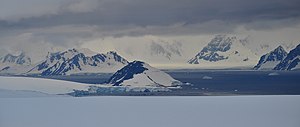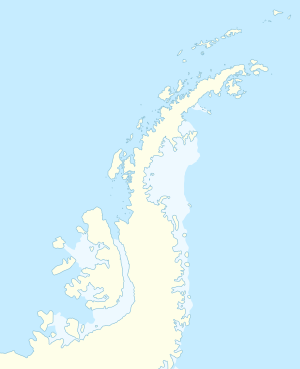Wyatt-Insel
| Wyatt-Insel | ||
|---|---|---|
 | ||
| Gewässer | Laubeuf-Fjord | |
| Geographische Lage | 67° 20′ 16″ S, 67° 41′ 8″ W | |
| ||
| Länge | 8 km | |
| Breite | 3 km | |
| Einwohner | unbewohnt | |
Die Wyatt-Insel ist eine 8 km lange und 3 km breite Insel vor der Loubet-Küste des Grahamlands im Norden der Antarktischen Halbinsel. Sie liegt 3 km südlich der Day-Insel nahe der Mitte des Laubeuf-Fjords.
Erstmals vermessen wurde die Insel 1936 bei der British Graham Land Expedition (1934–1937) unter der Leitung des australischen Polarforschers John Rymill. Dieser gab der Insel provisorisch den Namen South Island (englisch für Südinsel). 1948 nahm der Falkland Islands Dependencies Survey eine neuerliche Vermessung vor. Namensgeber der heute gültigen Benennung ist Vizeadmiral Arthur Guy Norris Wyatt (1893–1981), Hydrograph der Royal Navy von 1945 bis 1950.
Weblinks
- Wyatt Island. In: Geographic Names Information System. United States Geological Survey, United States Department of the Interior, archiviert vom (englisch).
- Wyatt Island auf geographic.org (englisch)
Auf dieser Seite verwendete Medien
(c) Karte: NordNordWest, Lizenz: Creative Commons by-sa-3.0 de
Positionskarte der Antarktischen Halbinsel
Autor/Urheber: Vincent van Zeijst, Lizenz: CC BY-SA 3.0
Laubeuf Fjord in the Antarctic Peninsula region, seen from a position high on the Wormald Ice Piedmont on Adelaide Island. Viewing direction is toward the NE. In the centre, behind some of the ice cliffs of the piedmont, is Webb Island. Left of Webb Island and further away is Wyatt Island. All the mountains in the background are on the Arrowsmith Peninsula, which is part of the Loubet Coast of the Antarctic Peninsula. The dark mountains at the right edge are the northernmost peaks of the Haslam Heights. The long front of coastal ice cliffs left of these peaks are the mouths of the Vallot Glacier and Ward Glacier. The large mountain behind this ice front is Pryor Peak; it is more than 1000 m high and is part of the Tyndall Mountains.


